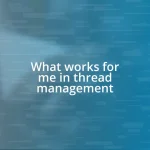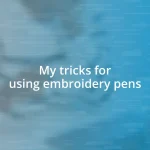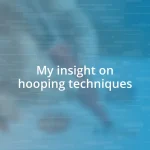Key takeaways:
- The fusion of textiles and digital art creates a new dimension of design, enhancing emotional connections and storytelling through visual experiences.
- Key techniques for blending these mediums include layering, color sampling, and tactile integration to evoke curiosity and engagement from viewers.
- Showcasing blended art projects fosters dialogue and community, illustrating how mixed mediums can resonate emotionally and spark collaboration among artists.

Understanding textile and digital art
Textile and digital art may seem like two distinct worlds, yet they share a profound relationship rooted in creativity and expression. I remember the first time I merged fabric swatches with digital patterns; it was like opening a door to a new dimension of design. Isn’t it fascinating how a simple printed textile can transform into an immersive digital experience with just a few clicks?
Exploring the textures of textiles, I often feel that they possess their own stories, each fiber holding the potential to evoke emotion. Take, for instance, a handwoven piece—it carries history and warmth, which I’ve found is sometimes lost in digital replication. How do you think this interplay between the tangible and the virtual can influence our perception of art?
When I’m experimenting with blending these mediums, the process becomes an exploration of possibilities. I find that each combination reveals a new narrative—digital graphics can enhance the cultural significance of fabric choices in unexpected ways. Isn’t it exhilarating to think about how our artistic choices can create conversations that bridge the gap between tradition and innovation?

Techniques for blending materials
When blending textiles and digital art, layering techniques can produce stunning results. I often start with a base textile image, then overlay it with digital patterns or textures. This technique not only adds depth but also invites the viewer to explore contrasts between the tactile nature of fabric and the smoothness of digital visuals.
Another powerful method I use involves sampling colors from the textile and applying them to digital designs. For instance, when I create a digital pattern inspired by a vibrant rug, I select colors from the fabric itself. This not only harmonizes the two mediums but also creates a cohesive look that feels both rich and authentic. It’s incredible how a subtle hue can evoke the warmth of the textile it represents.
Finally, I’ve discovered that incorporating tactile elements in digital presentations can be impactful. By integrating physical textures into my digital displays, I’ve been able to create an interaction where viewers can almost feel the materials, enhancing their experience. It’s fascinating how this fusion sparks curiosity and opens up dialogue about the nature of art itself.
| Technique | Description |
|---|---|
| Layering | Overlaying digital patterns on textile images to create depth. |
| Color Sampling | Selecting colors from textiles for use in digital designs for cohesion. |
| Tactile Integration | Incorporating physical textures into digital art for enhanced viewer interaction. |

Creating cohesive design elements
Creating cohesive design elements is where the magic really happens when blending textiles and digital art. I’ll never forget the moment I found the perfect digital brush that imitated the soft, delicate feel of silk. Adding this element to my design not only drew the viewer’s eye, but it also sparked a deeper emotional connection to the sophisticated textile. It’s almost as if I could hear the rustle of the fabric as I integrated it into my artwork.
To achieve a unified look, consider the following elements:
- Color Palette Consistency: Use the same colors across textiles and digital elements for a seamless visual experience.
- Texture Harmony: Choose textures that complement each other, allowing the digital to enhance the physical.
- Thematic Alignment: Ensure that both mediums tell a cohesive story, whether it’s about culture, emotion, or design philosophy.
Creating these relationships enriches the viewer’s understanding and creates a more evocative piece. Each project I undertake feels like a conversation with the materials, allowing their unique stories to blend together beautifully.
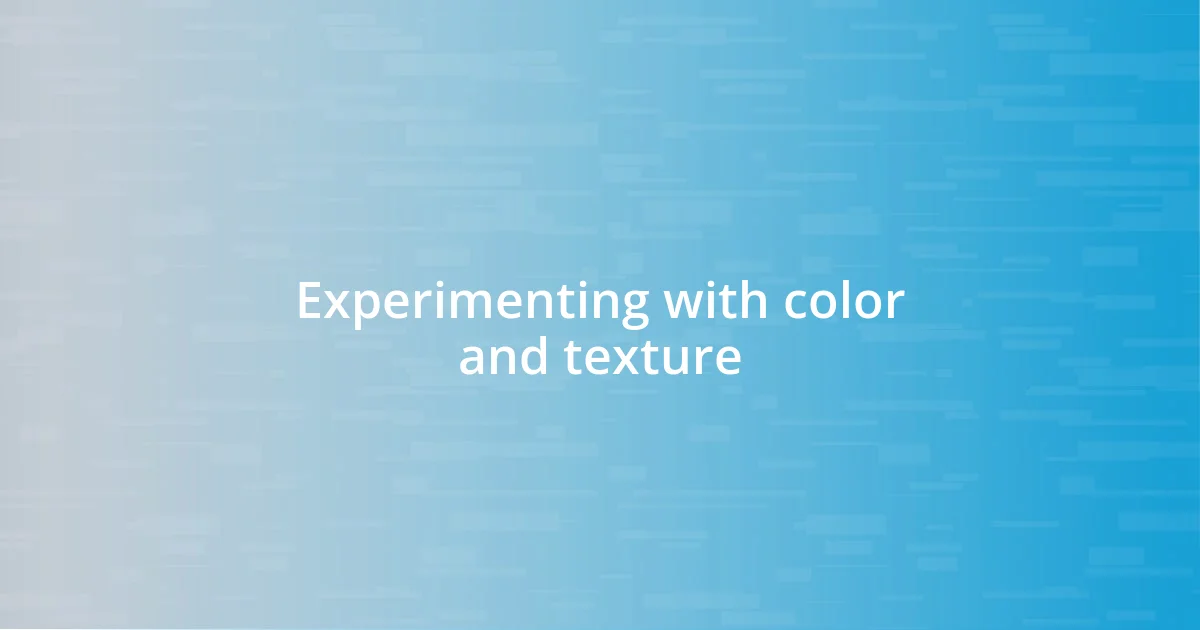
Experimenting with color and texture
Experimenting with color and texture can genuinely transform a project. I remember one particular instance when I decided to work with a deep emerald green textile. The color was so rich that it inspired me to explore various shades in my digital palette. As I blended hues of gold and cream into my design, I felt like I was painting a sunset on fabric. Isn’t it incredible how colors inspire creativity and shape our emotional connection to a piece?
Texture plays a pivotal role in this creative dance. One time, while working on a piece with a coarse linen backdrop, I paired it with smooth, flowing digital elements. The contrast was striking, evoking a sensation that was almost tactile, as though the viewer could reach out and feel the differences. This fusion of textures is not just an artistic choice; it engages the senses and invites curiosity. Have you ever felt that thrill when a texture surprises you in art?
I often find that the more I play with color and texture, the more unique my artwork becomes. Recently, I experimented with metallic threads in a digital design, infusing elements that almost shimmered against a soft, velvet base. The interplay of light and shadow created a dynamic energy that made me stop and smile. It’s in these moments of experimentation that I discover new pathways for creativity—what’s the last unexpected combination that sparked your imagination?
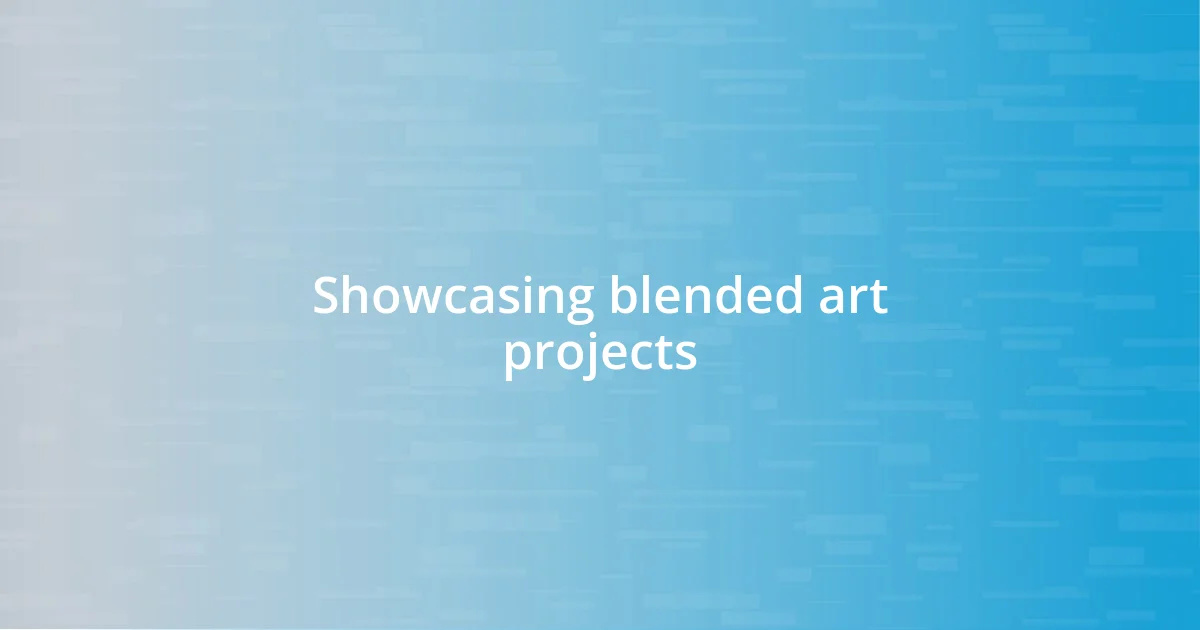
Showcasing blended art projects

Showcasing blended art projects truly allows me to convey the depth of my creative journey. I recall displaying a piece at a local gallery where I combined embroidered lace with digital floral motifs. The moment I saw visitors pause, entranced by how the threads danced with pixels, I realized that this blend didn’t just represent craftsmanship; it embodied storytelling. Have you ever witnessed the way art can spark conversations?
In another project, I created a tapestry that entwined digital imagery of a bustling cityscape surrounded by intricate fabric patterns reminiscent of my grandmother’s quilts. The rich textures and vibrant digital colors converged stunningly, evoking feelings of nostalgia and excitement. The response was overwhelming, with viewers sharing their own memories tied to urban life and craftsmanship. Isn’t it fascinating how blended mediums can create a shared emotional experience?
I often find that the act of showcasing these blended projects invites collaboration and inspiration. A recent virtual exhibition encouraged artists to share their processes, sparking discussions about techniques, challenges, and triumphs alike. It felt revitalizing to connect with others who resonate with this hybrid approach, reminding me that our art is not just an end product but a bridge to community and shared experiences. Have you participated in an event that opened your eyes to new artistic possibilities?


